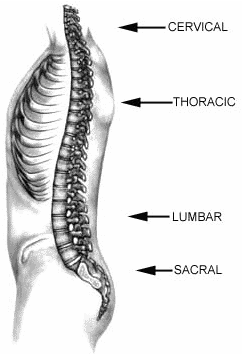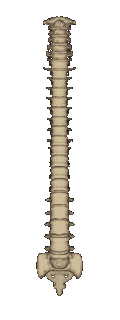The spine is one of the most vital parts of the human body, as
it supplies all of our vital organs with information from the central nervous system.
Upper Neck, Upper Cervical Spine (C1 - C2)
Head, face, upper neck, inner & middle ear, sympathetic nerve system, sinuses, eyes, auditory nerves and more. |
Mid/Lower Neck, Cervical Spine (C3 - C7)
Neck, shoulders, thyroid, tonsils, teeth, outer ear, nose, mouth, vocal cords, and more. |
Mid Back, Thoracic Spine (T1 - T12)
Arms, hands, heart, coronary arteries, esophagus, trachea, lungs, bronchial tubes, gallbladder, liver, stomach, pancreas, spleen, kidneys, ureters, adrenal glands, small intestines, and more. |
Lower Back, Lumbar Spine (L1 - L5)
Large intestines, appendix, abdomen, bladder, reproductive organs, lower back, lower extremities, ankles, feet, and more. |
Basebone or Tailbone, Sacrum and Coccyx
Hip bones, tail bone, buttocks, rectum, anus, and more. |
|
 |
Interactive Nerve Chart
(click on the rotating spine to see details of visceral innervation)
T he anatomy of the spinal column is extremely well designed to serve many functions. All of the elements of the spinal column and vertebrae serve the purpose of protecting the spinal cord, which provides communication to the brain, mobility and sensation in the body through the complex interaction of bones, ligaments and muscle structures of the back and the nerves that surround it. The back is also the powerhouse for the entire body, supporting and allowing the movements of our head, arms, and legs possible. he anatomy of the spinal column is extremely well designed to serve many functions. All of the elements of the spinal column and vertebrae serve the purpose of protecting the spinal cord, which provides communication to the brain, mobility and sensation in the body through the complex interaction of bones, ligaments and muscle structures of the back and the nerves that surround it. The back is also the powerhouse for the entire body, supporting and allowing the movements of our head, arms, and legs possible.
The human spine consists of 33 vertebrae, but as we age, natural fusion occurs leaving us with 26 articulating segments. There are 7 cervical (neck region), 12 thoracic (chest region), 5 lumbar (lower back region), 5 sacral (hip region), and 4 coccygeal (tailbone region) vertebrae. The vertebrae are held in place by muscles and strong connective tissue called ligaments. Most vertebrae have fibrous intervertebral disks between them to absorb shock and enable the spine to bend.
The spine normally has a slight curve. Abnormal curvatures may be present at birth. They may also result from disease, poor posture, or a strain on the muscles attached to the spine. Scoliosis occurs when the spine curves sideways. Hyperkyphosis, or hunchback, is a forward bending of the thoracic vertebrae that often affects elderly people. Hyperlordosis, or swayback, is an exaggerated curvature of the lumbar vertebrae. It usually affects overweight people and pregnant women.
Damage to the spine often occurs in the cervical and lumbar regions. Fractured cervical vertebrae may injure the spinal cord, resulting in a loss of sensation, paralysis, or even death. Whiplash is an injury to the muscles and ligaments attached to cervical vertebrae. It occurs when a sudden force, such as a rear-end car accident, throws the head backward. As people age, the intervertebral disk will lose water and some of its shock absorption function. This may lead to the pinching of spinal nerves, causing low back pain or sciatica (pain shooting down the leg).
|

